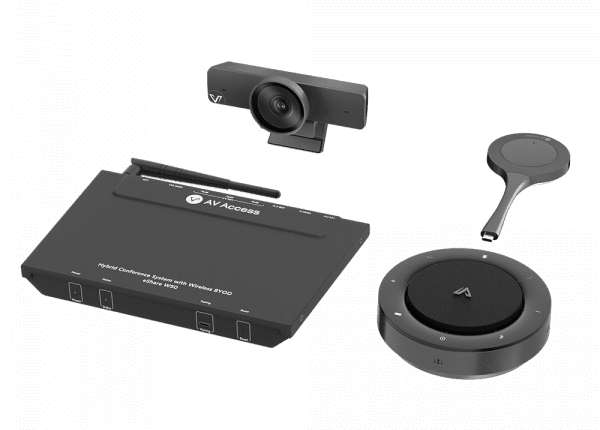Before BYOM
BYOM is short for “Bring Your Own Meeting” and the word is used in the professional AV industry to describe the revolutionary wireless conferencing technology. Before we get into “what’s BYOM”, we shall talk a bit about a related concept — BYOD.
BYOD is an earlier concept and also a broader one. It stands for “Bring Your Own Devices” — a policy that companies apply to allow employees to bring their own mobile devices to work in a work-related context, and access work-related resources on the device.
BYOD in Meetings
In a smaller scope, when BYOD is used in a meeting room context, it means that personal devices are allowed to connect to the meeting room system, join, or sometimes host the meeting.
Taking AV Access’s eShare W50 as an example, the presentation system integrates in-room meeting devices like the webcam, speakerphone, and the meeting room display and offers both wired and wireless methods (screen mirroring or with a dongle) for mobile devices to take command of them in a meeting.

This type of meeting room system allows employees to utilize the meeting room devices on their own laptops (sometimes electronics like smartphones and tablets are supported as well) and people can easily host a meeting, or join as a presenter in the meeting freely.
What are the benefits of BYOD?
People are most familiar with their own devices which they work on every day. Learning a new meeting room system or interface is now not mandatory. BYOD brings great flexibility and improves efficiency for team collaboration in a meeting, especially for hybrid conferencing.
What’s BYOM?
As we have mentioned before, BYOM stands for “Bring Your Own Meeting”. It’s obvious that this term is coined particularly for a meeting room context.
Bring Your Own Meeting (BYOM) refers to a meeting room solution with which participants can utilize their personal devices, such as smartphones or laptops, to host and control the meeting.
The meeting room’s technology responds to it on their devices and makes it more customizable than a conventional room-based system where dedicated in-room equipment dictates the meeting’s progression and structure.
BYOD vs. BYOM
They both look like something that supports bringing in people’s own devices. So, what’s the difference between BYOD and BYOM?
- Define your own meeting: BYOD does not alter the existing meeting room system and just makes it possible for people to access resources on their own devices, while BYOM is more dynamic and is a meeting room solution that not only allows external devices but also allows them to control and personalize the workflow.
- Choose your own VCS: Since a BYOM meeting room system is open and flexible, it is not locked to a certain VCS (Video Conference Service) like Zoom, Microsoft Team, etc. You can choose your own service that works best with your team.
- Ease of Use: BYOM enables people to take control of the meeting without any need to connect a physical device (for example, a cable or a dongle) to their laptop, which is sometimes described as a “touchless connection solution”. Your device is the dashboard.
In Between BYOD & BYOM
A wireless conferencing system is not necessarily in the scope of BYOD or BYOM. There might be something in between.
For a small or medium-sized team, a BYOM system that requires technical setup and maintenance may not be the best option. Touchlessness means that quick and easy communication via a cable plug needs now to be realized via a software way. Sometimes advanced software settings can be confusing.
In between BYOD & BYOM, a hybrid conference system like the upcoming AV Access eShare W80 supports both wired and wireless (via a dongle) connections to host the meeting, and wireless BYOD to engage in the meeting. This kind of meeting room solution integrates both hardware and software solutions, keeps the advantage of plug-n-play convenience, and gives the decision back to the users.
Conclusions
Meeting room technology is evolving and new products & concepts are also springing up. Users’ needs are down-to-earth and concrete. The most newest and advanced package may not be your best fit. Sometimes a simple BYOD could well cover your needs. If you have any questions and wanna find a meeting room solution that fits your needs, welcome to talk to our team at info@avaccess.com. Have a nice day!
Source: https://www.avaccess.com/blogs/guides/whats-byom-hybrid-conferencing/

